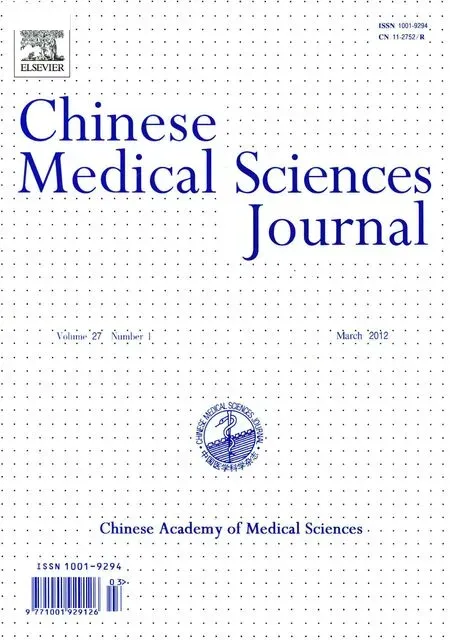Extracorporeal Membrane Oxygenation Support in Resuscitations for Acute Myocardial Infarction with Cardiac Arrest
Li Feng*,Yong Yuan,Jian-ting Dong,Ying Han,Zhi-hua Deng,Wei-qi Liu,and Bin-fei Li
Heart Center,Zhongshan Affiliated Hospital of Zhongshan University,Guangdong 528403,China
MORTALITY rate of acute myocardial infarction(AMI) patients could be as high as 80%,if present with or develop fatal arrhythmia and cardiac arrest.Some patients,despite the treatment with inotropes and intra-aortic balloon pump,are not hemodynamically stable enough to undergo emergent revascularization.The use of extracorporeal membrane oxygenation (ECMO) can help stabilize circulation and respiration,which could be a potential solution for patients under such critical circumstances.In this paper,we describe the application of ECMO for the resuscitations of 4 cardiac arrested AMI cases.
PATIENTS AND METHODS
Patients
Four patients were collected from December 2007 to December 2010.They were all male,aged 50±14 years(range,37-69 years).Their chest pain lasted for 8.5±8.1 hours on average (range,2-20 hours).Three patients had acute anterior wall infarction,and the other one had posterior wall infarction.Cardiac respiratory arrest developed due to third-degree atrioventricular block (AVB) and ventricular fibrillation.Cardiopulmonary resuscitation,epinephrine,and respirator were used for all the four patients.ECMO was subsequently applied when unstable hemodynamic status was observed 10-15 minutes after the above resuscitation measures.
Implementation of ECMO
The ECMO apparatus consists of a blood pump with raceway tubing,a venous reservoir,a membrane oxygenator,and a countercurrent heat exchanger (Medtronic Inc.,Minneapolis,MN,USA).Right femoral artery and vein were used as the site for venoarterial bypass.A cannula was placed into the right femoral vein,through which blood was drained to a venous reservoir and then actively pumped by a roller pump through the oxygenator,where gas exchange occurredviacountercurrent flow of blood and gas.The blood was warmed to body temperature by the heat exchanger before returning to the patient through a cannula placed into the right femoral artery.The whole bypass circuit was pre-coated with heparin.No additional systemic anticoagulation therapy was necessary within the first 24 hours.Twenty-four hours after changing oxygenator,heparin was administered with frequent monitoring of activated clotting time,which should be maintained at 160-180 seconds.The initial speed of the roller pump was 50-70 mL/(kg·min),then adjusted according to the hemodynamic status and blood gas levels of the patients.Distal femoral cannula was placed in order to prevent ischemic necrosis of lower extremities.When the speed of the roller pump decreased to 15 mL/(kg·min),both hemodynamics and blood oxygen saturation were stable.If such stable conditions maintained for one hour,ECMO would be stopped first,and the removal of cannulae would be considered.Otherwise,longer ECMO support wass necessary.
RESULTS
The four cases all achieved stable hemodynamic status with arterial pressure of 85-105/55-65 mmHg.Oxygen saturation (SaO2) was about 94.25%±3.86%.Electrocardiography monitoring showed that two cases with anterior wall infarction restored to sinus rhythm within 30 minutes of ECMO support,while the other two cases stayed as third-degree AVB.
All the four patients received coronary intervention under the ECMO support.Two cases were found to have 3 diseased vessels each;the other two had 2 diseased vessels each.Complete occlusions of proximal left anterior descending arteries were observed in three patients,3 stents were installed for each case.One patient had a complete proximal right coronary artery occlusion,which was treated by inserting one stent.In this patient,due to alternate third-degree AVB and second-degree AVB occurring during the stent implantation procedure,a right temporary pacemaker was installed.The mean ECMO support time was 13.63±9.88 hours (range,5-27 hours).At the time of ECMO removing,echocardiography showed that the patients’ left ventricular ejection fraction improved from 0.29±0.13 before interventional revascularizations while under ECMO to 0.47±0.11.Hemodynamics was stable.Arterial pressures were maintained above 90/55-60 mmHg,SaO2above 95%.Three cases were discharged,one case died because of multiple organ failure.One patient suffered from lymphatic fistula at the incision on right femoral artery.No other complications occurred in the other patients.
CONCLUSIONS
ECMO could effectively provide cardiopulmonary support for cardiac arrest patients with minor invasive procedures,therefore ensure further interventional therapy,and increase the survival rate of AMI patients.It can relieve the burden of pre-load by diverting the venous blood to the venous reservoir.Membrane oxygenator pumps the oxygenated blood back to circulation,which not only maintains desirable blood pressure,but also benefits the cardiac muscle and the other organs with better perfusions.In the current report,all the four cases achieved stable hemodynamics and received interventional revascularization treatments.ECMO was successfully implemented and removed in all those cases,resulting in smooth recovery except for one death due to 3-vessel involvement and multiple organ failure.
 Chinese Medical Sciences Journal2012年1期
Chinese Medical Sciences Journal2012年1期
- Chinese Medical Sciences Journal的其它文章
- Management of Pregnancy with Ankylosing Spondylitis
- Applicability of Community Periodontal Index Teeth and Random Half-mouth Examination to Gingival Bleeding Assessment in Untreated Adult Population in Beijing
- Personalized Management of Anastomotic Leak after Surgery for Esophageal Carcinoma
- Spectral Domain Optical Coherence Tomography of Vogt-Koyanagi-Harada Disease:Novel Findings and New Insights into the Pathogenesis
- Radiofrequency Ablation of Hepatic Paragonimiasis:a Case Report
- Electrocorticography with Direct Cortical Stimulation for a Left Temporal Glioma with Intractable Epilepsy
